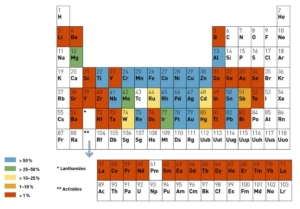Articles Menu

Feb. 15. 2024
Here’s some bad news for folks who see a circular economy as a way out of the polycrisis: Trends in global materials use, which recently bent modestly in the direction of circular flows, are flattening once again. The Circle Economy Foundation in Amsterdam reported in January that secondary materials amounted to only 7.2 percent of all materials in the global economy in 2023, down from 9.1 percent in 2018. (Secondary materials are recycled, reused, or repurposed materials.) Put differently, a growing share of materials used in the global economy in 2023 came fresh from mines, forests, farms, or oceans.
The authors of the Circularity Gap Report 2024 assert that “we cannot recycle our way out” of unsustainable global materials use. Instead, they say, we need circular economies, economies that rely not only on recycling, but also on reduced consumption of materials, longer-lasting products, and greater use of renewable resources. Their counsel makes good sense, as far as it goes.
But circular economies are not comprehensive enough to make economies sustainable. Helpful as they may be, circular strategies should not be mistaken for the steady state economy.
Building circular economies is a huge challenge given the massive flows of materials that course through the world’s economic veins. In the past half century, societies worldwide have more than doubled their extraction of biomass (like forest products) and fossil fuels, and nearly quintupled the mining of non-metallic minerals. This heavy use has accelerated as economies and populations have grown, so that in just the five years between 2016 and 2021, humanity consumed 28 percent of all the materials used since 1900.
Given this acceleration, and because material flows in most economies are linear, the appetite for materials is projected to grow as economies expand. Already, the world’s economies consume 100 billion tons of materials each year. By 2050, just a quarter century away, materials extraction is projected to double relative to 2015 levels, “threatening a total breakdown of Earth’s life support systems, which are already at a breaking point,” the report says.

Increase in global extraction of materials, by group (International Resource Group).
Indeed, humanity’s intensive use of materials explains much of the environmental damage generated by economies worldwide. UNEP’s International Resource Panel reports that natural resource extraction and processing in 2017 was responsible for 90 percent of global biodiversity loss, 90 percent of water stress, and 50 percent of global greenhouse gas emissions.
Moreover, the Circularity Gap report draws a direct line between resource use and the six breached “planetary boundaries” identified by the Stockholm Resilience Centre. (Planetary boundaries define a “safe operating space for humanity” in nine natural domains. The six breached domains are climate change, biosphere integrity, land use, freshwater use, biogeochemical flows, and novel entities.) Planetary boundaries analysis gives a picture of the extent to which current consumption of materials exceeds nature’s capacity. The projected increase in materials consumption will deepen our overshoot of nature’s supply of goods and services, and possibly extend that overshoot to other domains.
The Circularity Gap identifies high-leverage economic sectors for intervention. The 2023 report found that applying 16 circular solutions across four domains—the food system, the built environment, mobility and transport, and manufactured goods and consumables—could reverse the overshoot of five planetary boundaries and limit warming to two degrees.
It also outlines different strategies by country income group. Industrial countries could focus on the built environment, emphasizing renovation and certification of materials in the secondary market, and on manufacturing and design for circularity. Middle-income nations might also prioritize manufacturing, in particular directing capital investments to promote green tech. Low-income countries would focus on the food system, ensuring that smallholder farmers have access to land and affordable credit. They would also use building codes and public procurement to promote circular building practices.
For all its merits, the report fails to acknowledge the limits of circularity, and this omission arguably misleads readers regarding its potential.
Circular economy advocates overlook a few basic physical truths in their enthusiasm for their model. First is the reality that economic activity wears down the world it transforms. Materials and fuels dissipate with use or are lost, reducing the usable stocks of resources and ensuring that virgin materials in the future will come from less accessible sources.
Evidence of the increased difficulty in finding resources is everywhere. Oil drilling, once a matter of sticking a pipe in the ground, now requires exotic subterranean technologies like fracking or even drilling at the bottom of the ocean. Meanwhile, metal ores are typically leaner overall: The global average copper ore contained four percent copper in 1900 but only 0.62 percent in 2012. Water tables are falling in many more places than they are rising, with nearly half of the nearly 85,000 wells in the USA having declined significantly over the past 40 years. In a world of finite resources, ongoing extraction will invariably reduce available stocks.
Recycling can delay resource depletion, but recycling cannot make materials flows fully circular. Some materials are uneconomic to recycle. Others, like paper, decline in quality with each round of recycling. Still others require large amounts of energy to separate component elements. And some recycling—of plastic, for example—requires coordination across various flows for the full recycling potential to be achieved. Thus, even valuable materials like metals are recycled at only modest levels, often less than 50 percent.
In 2011, the International Resource Panel assessed global recycling rates and found that fewer than twenty elements had rates above 50 percent (blue); virtually none were above 75 percent. More than thirty elements (red) had no functional recycling at all. In sum, a majority of the elements employed in the economy were used just once, then were lost from economic stream, mostly to landfills or incinerators, or to dissipation.

Most elements in the global economy are recycled at low rates, if at all. (International Resource Panel)
Governments worldwide have set seemingly ambitious recycling goals to increase the share of material that circulates. The USA’s National Recycling Goal is 50 percent by 2030. The EU has set recycling goals of 65 percent for municipal solid waste by 2035, 70 percent of construction waste, and 55–80 percent of electronic waste. These goals are ambitious only by the historical standards of industrial economies.
But consider that mathematically, a 75 percent recycling rate implies that after five rounds of recycling, only 24 percent of the original material remains in circulation (if the share not recycled never enters a recycling stream). At a 50 percent recycling rate—the U.S. goal for 2030—only 3 percent of the original material remains after five rounds.
While lofty recycling goals can slow the loss of materials, recycling still leaks meaningful quantities of increasingly scarce materials. It does not produce a circular economy.
For these reasons, Herman Daly assessed the potential of a circular economy very critically. A circular economy can approximate a steady state economy only if it “relies on natural biophysical cycles powered by the sun” and if its scale does not exceed the biosphere’s capacity for regeneration and absorption. The scale requirement is what is neglected in conventional economics—and arguably is overlooked by proponents of circular economies.
Moreover, Daly asserts that the circularists also fail to appreciate an idea familiar to Herald readers, the trophic structure of the economy. Just as primary producers are the base of production in the pyramidal economy of nature, providing nutrients and energy for consumers at trophic levels above, so do agriculture and extraction serve as the base of the human economy, feeding higher levels of economic activity including manufacturing and services. Indeed, Brian Czech, originator of the trophic theory, has written of the “triangular economy” (invoking the shape of trophic level diagrams) as a counterpoint to circular economy enthusiasts.
One implication of the trophic theory is that manufacturing and services atop the pyramid cannot grow any faster than the agriculture and extractive sectors at the base—and clear limits apply to these. I don’t know of any circular economy advocates who include these limitations in their analysis.

Phenomena that seem to defy physics are usually an illusion. (Deviantart, CC BY 3.0 DEED)
So Daly sets a pretty strict standard for a circular economy. For him, a circular economy bounded by nature would surely look more like the Flintstones than the Jetsons. (Outside the cartoon realm, I wonder if a truly sustainable circular economy would be akin, in principle if not in all its detail, to life in “A Swiss Family Robinson.” In that 1960 film, human cleverness transforms natural materials into goods that meet daily needs, without stressing nature.)
In Daly’s acceptable circular economy, the focus of human advancement would likely shift from the material to the cultural, with material inputs playing an essential, but circumscribed, supporting role. Global Circularity 2024 points to progress in this direction in Angola, Eswatini, Togo, Nepal, the Gambia, countries that made real progress in life expectancy, nutrition, and energy access without increasing their materials use, and in some cases, while decreasing it.
In a similar spirit, other countries are pursuing a “wellbeing economy” strategy that focuses more on quality of life than on material accumuliation. The Wellbeing Economy Governments partnership (WEGo), which includes New Zealand, Scotland, Iceland, Wales, and Finland, are leaders in this regard, using a range of indicators for wellbeing to guide government decision-making, for example.
In sum, a circular economy can help the world’s economies use resources more judiciously. But it would not guarantee that materials use is capped, nor that materials extraction and use would remain within boundaries set by nature. Only degrowth toward a steady state economy—likely assisted by circular economy principles—can create such a truly sustainable civilization.
Teaser image credit; Durable materials and repurposed structures contribute to circularity. (Kevin Martin Jose, Unsplash)